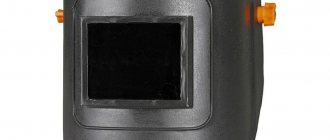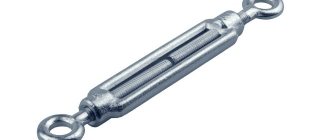A lanyard is a rigging device that allows you to attach ropes, cables, chains, ropes to supports and easily adjust the tension of guy wires when they weaken or sag during operation. These simple screw devices were initially used on ships, but gradually began to be used in other areas of human activity, for example, when installing or strengthening structures, securing transported cargo, when it is necessary to create a large tension force.
Today, cable tensioners are successfully used in various engineering structures; they help prevent emergency situations during cargo transportation, provide tension on cable fences, cable networks between houses, and hold antennas, masts, lightning rods, and bridges. In this case, the fixation of the cable can be temporary (for example, securing loads or installing tents) or permanent (for example, installing curtain strings or strengthening engineering structures).
The intended purpose of the device is determined by its design, standard size and strength characteristics. The most common standard mounting lanyard is a screw tie, depending on the size of which you can create a tension force from several kilograms to tens of tons. For high loads, only DIN 1478 (fork-fork) lanyard is used.
Operating principle and types of screw lanyards
A screw cable tensioner consists of a coupling-housing with two threaded holes for screws with different thread directions. When the couplings are rotated in one direction, they are screwed into the body, and in the other they are unscrewed, which allows you to continuously change the overall length of the tightening device. Adjustment does not require special physical effort and can be done at any time as needed.
The turnbuckle body has two versions - open or closed (bushing). The latter are suitable for harsh operating conditions, when there is a risk of damage, icing, clogging of the tension mechanism with dirt or sand. According to the manufacturing method, couplings are welded, stamped, forged and cast.
Screw heads are made in the form of a hook, a ring, a fork, a pin, or a combination of these, such as a hook-ring or a fork-eye. A high level of reliability is ensured by fork-fork tensioners. A welded stud-stud lanyard is used in cases where it is necessary to connect it with other rigging elements or structures by welding, thereby creating a permanent connection.
Device and characteristics
The product consists of 4 elements, namely:
- Cast coupling having two threaded holes. It can be in the shape of an ellipse or a rectangular frame.
- Several elements for gripping loads (slings). Each of the elements is a rod with a thread on the opposite part. On these sides there is a head in the form of a fork, loop or hook.
- Washers, which are necessary to ensure that the current load is distributed evenly.
- Locking nuts that can prevent the tensioner from loosening on its own.
Classification and labeling
Since the lanyard is used in conditions of adverse atmospheric influences, the fasteners chosen are:
- Stainless steel;
- Made of galvanized metal.
Also, products are classified depending on the type of fastening at the ends of the screws:
- C+O (hook/ring);
- O+O (ring/ring);
- C+C (hook/hook).
FOR REFERENCE!
The ring hook type can be closed or open. Closed is used in most modern models; it is mainly used for securing fiber optic cables.
The lanyard marking contains information about the length and type of coupling, type of head, thread size, indicating the location of the left thread. The permissible load value is also indicated. The coating and type of construction is reflected in the technical documentation.
Material
To produce this fastener, only high quality steel is used. The product itself is produced by forging, then a protective layer is applied. This procedure is called “passivation” and is carried out by hot-dip galvanizing. Thanks to passivation, the fasteners are protected from corrosion and can be used for a long time in conditions of high humidity without loss of quality.
Couplings
Couplings are manufactured in three ways (GOST 9690-71):
- Welding;
- Casting;
- Stamping.
They also produce couplings of both open and closed types. Open type products can withstand up to 6.3t, and closed type - up to 20t.
Size and weight
Lanyard characteristics:
IMPORTANT!
The weight of a typical product depends on the material of construction and manufacturing methods.
Load capacity
The technical documentation for the product indicates its load capacity. It may depend on the type of gripping device.
Standards, loads and sizes of lanyards
In the post-Soviet space, their production is regulated by GOST 9690, in Europe they adhere to the standards DIN 1480 and DIN 1478, in the USA ASTM F1145-05 applies.
Lanyard DIN 1480 is a general-purpose device not intended for work that involves lifting loads. It withstands high static loads, perfectly holds tension ropes and ensures reliable fixation of vertical structures. Its load capacity ranges from a few kilograms to 3 tons. In everyday life it is used, for example, for stretching clotheslines or strings for curtains.
Lanyard DIN 1478 is a cargo lanyard with fork hooks, made of high-strength steel, has a safety factor of at least 4:1 and is designed for higher static and dynamic loads (up to 10 tons). Approved for use in systems with high tension, for example, when securing multi-ton cargo on transport, in the construction of suspension bridges, for organizing guy wires for awnings, tents, and massive antenna mast systems.
The size of the screw tie is determined by the diameter of the thread, which has standard metric characteristics and a diameter from M5 to M56. The most popular models: hook-ring lanyard M8, M10, M12, M16 or ring-ring M8, M10, M12. Another important parameter of the product is its length when fully untwisted (L1) and in the screwed state (L), the difference between them (L1-L) is a linear value within which the tension of the rope branch can be adjusted.
Operating parameters of lanyards
For the considered devices with couplings, the main operational characteristics are:
- Permissible load.
- The length of the coupling (less commonly, its transverse dimensions).
- The length of the lanyard itself with the claws unscrewed (the threaded part does not come out of the coupling body, but completely fills it).
The standard defines an unambiguous relationship between the diameter of the threaded hole in the turnbuckle coupling and its load-bearing capacity. In particular, for stamped couplings the following relationships exist:
- with a load of up to 200 kg - M8;
- with a load of up to 300 kg - M10;
- with a load of up to 500 kg - M12;
- with a load of up to 1200 kg - M16;
- with a load of up to 2000 kg - M20;
- with a load of up to 3150 kg - M24, etc.
The maximum load-bearing capacity of a standard cargo lanyard with an open coupling is 6300 kg; if higher operational loads are required, the rigging is designed and manufactured according to individual orders. Closed turnbuckles are designed for a load capacity of up to 20,000 kg (with the exception of welded coupling structures, the load on which should not exceed 1,500 kg).
The load-carrying capacity of the lanyard is also determined by the type of cargo grip. The lowest permissible values are for hook-to-hook type grips, and the highest are for fork-fork type grips. The design of all components of the lanyard should not have stress concentrators, therefore, when transitioning from one part of the coupling, fork, hook, etc., the maximum possible radius transitions are provided.
The following mandatory requirements apply to standard lanyard designs:
- Strength category after stamping is not lower than KP25 according to GOST 8479;
- Lock nuts must be manufactured in accordance with GOST 5919 using cold heading methods. Thread grooves are not allowed;
- Metric threads on all parts must comply with the requirements of GOST 24705;
- Cast parts must be free of internal and external macrostructure defects (selective quality control must comply with the requirements of RD 34.17.402);
- Welded versions of couplings are performed using E42A electrodes with mandatory cleaning of finished seams.
- Steel lanyards have a surface anti-corrosion coating.
Galvanized or stainless steel lanyard?
When choosing a screw tie, you should take into account the external conditions in which it will work and the degree of aggressiveness of this environment. For dry rooms and temporary outdoor use, it is enough to purchase a galvanized cable tensioner. For constant use outdoors, in places with a humid and frosty climate, closed stainless steel lanyards made of A2 steel are suitable, and in particularly aggressive conditions (chemical production, maritime shipping, hot shops, pools with chlorinated water) - made of acid-resistant steel A4.
Did you know?
If you need to cut a thread in a hole and don’t have a tap holder at hand, a regular screw lanyard will help out. Clamp the shank of the tap between its screws, and use the body of the device as a driver.
Areas of application of lanyards
Due to their simplicity of design and wide possibilities for use, lanyards are currently actively used in the following areas:
- Construction of buildings and bridges.
- Lifting equipment.
- Laying cable networks between houses.
- Shipbuilding, shipping and yachting.
- Fastening sports equipment.
- Installation of antennas and flagpoles.
- Temporary installation of tents and marquees.
- Additional support for facilities under reconstruction or in disrepair.
In this case, the fixation of the cable can be either temporary (for example, a cargo lanyard) or permanent (for example, the construction of bridges, fastening antennas).
Cable-stayed fastenings (chain tensioners)
Hook-hook chain lanyard (ratchet) is the name of a cable-stayed fastening with hook grips, designed for securing large and heavy loads with chains on transport platforms. The devices have a ratchet or lever mechanism, through which a large tension force is easily created.
The chain tie-down is a simple and reliable manual mechanism used all over the world in securing systems for large-size and heavy-tonnage loads. It is used to tension fastening chains, which in turn securely fix and hold the load, preventing its spontaneous movement or fall during transportation by road, rail and other modes of transport. Based on their design, they come in two types, the characteristics of which are discussed below.
Ratchet type tightening device
This chain lanyard consists of a ratchet mechanism with a rotation switch and two rotary hooks located at opposite ends of the device. The tension of the fastening chains is ensured by the convergence of the hooks by turning the mechanism handle. The positive features of this ratchet include:
- ease of installation of the device into the mounting system;
- application of minimal physical effort when working;
- lever that does not require additional fixation.
Lever type tightening device
Its design also consists of two rotary hooks that ensure the engagement of the chain fastening branch, as well as an eccentric lever mechanism. In this case, the tension of the chains is ensured by applying manual force to the eccentric mechanism, which, passing through the point of maximum tension, self-clamps. Reliable fixation of the lever is ensured by the chain itself, which pushes the device to the sides and thereby prevents the mechanism from opening. The positive features of this chain lanyard include:
- minimal installation time;
- simplicity of design;
- small sizes;
- absence of a protruding lever in the operating position of the device.
How to choose a lanyard?
When choosing a product, special attention should be paid to such a parameter as the maximum permissible load. If a lanyard is used to secure a load in a vertical position, then a large margin is required, approximately 600-900%.
Safety is also an important point. It is necessary to understand how securely the rope or cable grips the clamp.
IMPORTANT!
Design types with two hooks have the least safety.
When choosing, you should carefully study the product markings, which are indicated on the case or technical documentation; any certified product must have it.
In addition to the load, the size of the element must be taken into account. For example, if the installation will be carried out in cramped conditions. You also need to pay attention to the presence of anti-corrosion protection.
Before use, you need to check the lanyard as follows:
- Check if the threads match;
- Inspect for mechanical damage and deformation;
- Check for the absence of cracks and grooves.
IMPORTANT!
The kit must include lock nuts. Without them, the work of the lanyard may be meaningless, since under the influence of the load it will unwind.
GOSTs and other normative standardization documents
Requirements for lanyards are reflected in the standards:
- GOST 9690-71 - domestic standard;
- DIN 1748, DIN 1480 - European standards.
Operating principle and tension adjustment
Correct operation of the tensioners should ensure the simultaneous rotation of two screws in opposite directions. As soon as the tension reaches the permissible force, the process stops. The tension is easy to adjust. It can be loosened at any time without much physical effort.
Requirements for lanyard parts
In closed designs, the threads must be located in the coupling body. This option is safe, since if the gripping device is destroyed, it will not fly apart in all directions. That is why the permissible tension value for closed lanyards is greater.
The manufacturing technology of couplings is of great importance. Stamped couplings are more durable. And welded ones have the lowest load-bearing capacity.
Where to buy a lanyard in St. Petersburg?
In our Krepkom store you can buy hook-ring, ring-ring, hook-hook, fork-fork lanyards, as well as chain ratchets for transporting heavy equipment, equipment, and logs. All of them have been load tested and have a large safety margin (4:1, 5:1, 6:1). How much do these rigging devices cost? – The price of a lanyard largely depends on its size. The price range for “Strong” is as follows: from 150 to 7,000 rubles per unit of goods.
We hope this review article will help you make the right decision when choosing a rigging lanyard for tensioning a cable or chain.
Chains, slings, rigging Updated: 07/13/2021 13:55:41
Operating conditions for lanyards and rules for working with them
Once the desired tensioner has been selected and purchased, you can begin installing it, namely:
- Treat all structural elements with gasoline.
- Polish with a felt wheel.
- Lubricate moving parts.
- Insert the screw into the thread and turn it back and forth.
- Assemble the structure with the cable and adjust the tension force by rotating the screw.
- Periodically inspect the structure and, if the tension force is insufficient, make adjustments.
All specified types of lanyards are manufactured by GPO-Snab upon request. The price of lanyards depends on their design and load capacity. The price is provided individually, upon request.
We organize delivery of lanyards throughout Russia: to Moscow, St. Petersburg, Chelyabinsk, Krasnoyarsk, Novorossiysk, Chita and other cities.
What should you consider when choosing?
- The chain type lanyard is designed for axial load, which means that it is not used for lifting loads.
- Chain ties must be selected taking into account the load power. Here it is also important to take into account the parameters of the chain, which depend on the steel class and load capacity.
- Devices must be certified and labeled.
offers a wide selection of different standard and custom lanyards. All supplied products comply with regulatory documents and are confirmed by quality certificates.
Chain lanyard with lever | ||||||||||||
| Size | Tonnage (t) | Chain, mm | Minimum ultimate load (t) | Maximum permissible load (t) | Weight, kg | Dimensions (cm) | ||||||
| A | B | C | D | E | F | G | ||||||
| 5/16-3/8 | 2,4 | 8-8 | 4,9 | 9 | 4,773 | 64.008 | 58.928 | 49.5046 | 39.497 | 28.498 | 28.498 | 1.295 |
| 3/8-1/2 | 4,2 | 10-8 | 8,36 | 15 | 5,864 | 72.39 | 67.0052 | 56.007 | 44.805 | 32.994 | 30.988 | 1.498 |
Chain lanyard with ring-ring ratchet | ||||||||||
| Size | Tonnage (t) | Chain, mm | Minimum ultimate load (t) | Maximum permissible load (t) | Weight, kg | Dimensions (cm) | ||||
| A | B | C | E1 | F | ||||||
| 5/16-3/8 | 2,4 | 8-8 | 4,9 | 9 | 3,545 | 35,356 | 3,302 | 6,604 | 55,118 | 2,006 |
| 3/8-1/2 | 4,2 | 10-8 | 8,36 | 15 | 3,545 | 35,356 | 3,302 | 6,604 | 55,118 | 2,590 |
| 1/2-5/8 | 5,9 | 13-8 | 11,81 | 20,9 | 3,864 | 35,356 | 3,302 | 6,604 | 56,3118 | 2,590 |
Chain lanyard with ratchet hook-hook | ||||||||||||
| Size | Tonnage (t) | Chain, mm | Minimum ultimate load (t) | Maximum permissible load (t) | Weight, kg | Dimensions (cm) | ||||||
| A | B | C | E | E1 | F1 | G | ||||||
| 5/16-3/8 | 2,4 | 8-8 | 4,9 | 9 | 4,773 | 64.008 | 58.928 | 49.5046 | 39.497 | 28.498 | 28.498 | 1.295 |
| 3/8-1/2 | 4,2 | 10-8 | 8,36 | 15 | 5,864 | 72.39 | 67.0052 | 56.007 | 44.805 | 32.994 | 30.988 | 1.498 |











